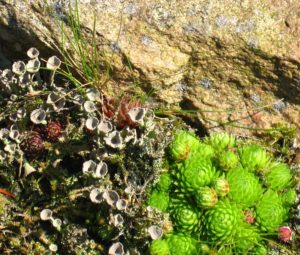 Not all backyards are suitable for traditional gardens, particularly when you live in a place that tends to experience droughts, like I do. You might also be dealing with a steep slope, have a really small yard, or just have an awkward landscape design. A rock garden can be a creative alternative when a regular garden just won’t work. A rock garden is made up of a variety of rocks, stone slabs, and boulders strategically placed on a plot of ground. While authentic Japanese rock gardens are often filled with just rocks, rock gardens here in America usually have plants, too.
Not all backyards are suitable for traditional gardens, particularly when you live in a place that tends to experience droughts, like I do. You might also be dealing with a steep slope, have a really small yard, or just have an awkward landscape design. A rock garden can be a creative alternative when a regular garden just won’t work. A rock garden is made up of a variety of rocks, stone slabs, and boulders strategically placed on a plot of ground. While authentic Japanese rock gardens are often filled with just rocks, rock gardens here in America usually have plants, too.
Getting Started
When designing your rock garden, you’ll want to take the size of the space into consideration. In smaller yards, one of the best techniques is to build a round, raised garden bed using rocks of various sizes. This type of rock garden requires minimal maintenance and can be constructed in a small nook.
If you’re working with a larger space, you may want to create a more natural-looking rock garden by spreading the rocks across the landscape. Before placing rocks, be sure to prepare the area to prevent weeds from popping through the gaps. Layers of newspaper or a weed-resistant fabric are usually effective.
Choosing Rocks
The types of rock you choose for your rock garden will depend on a few factors, such as your location, your budget, and the overall look you’re going for. Ideally, you want to choose rocks that are found in your region so that they blend well with your existing landscape.
Porous rocks are best for rock gardens, as they are more prone to weathering, which gives the rock the color and character most gardeners desire. Remember, the goal in a rock garden is to make the stones appear natural in your yard. This means you should avoid rocks that are overly colorful or flashy.
Placing the Rocks
When putting rocks in your rock garden, you’ll want to keep a few things in mind. First, be sure to vary the sizes of your rocks to achieve a more natural look, and leave spaces in between the rocks for plants.
To mimic nature, place rocks and plantings in random groupings. Also, bury portions of the rocks into the soil, which not only stabilizes them but makes them look like they have always been there. Use larger rocks around the outside of the garden to create a visible perimeter for the rock bed.
Planting the Garden
While flowers are a beautiful addition to a rock garden, not all plants thrive in this type of environment. Perennials are a practical choice, as they are more resilient to the changing seasons. Some of the most popular plants for rock gardens include:
- Euphorbia
- Yellow alpine alyssum
- Coral bells
- Rock cress
- Hens and chicks
- Candytuft
- Sedum
- Thrift
- Soapwort
Before making a decision, check your plant’s hardiness based on where you live. Opt for plants that are drought-resistant and low-maintenance. And if the plants you choose require a lot of sun, be sure to avoid putting them directly next to large rocks or boulders that may create too much shade.
